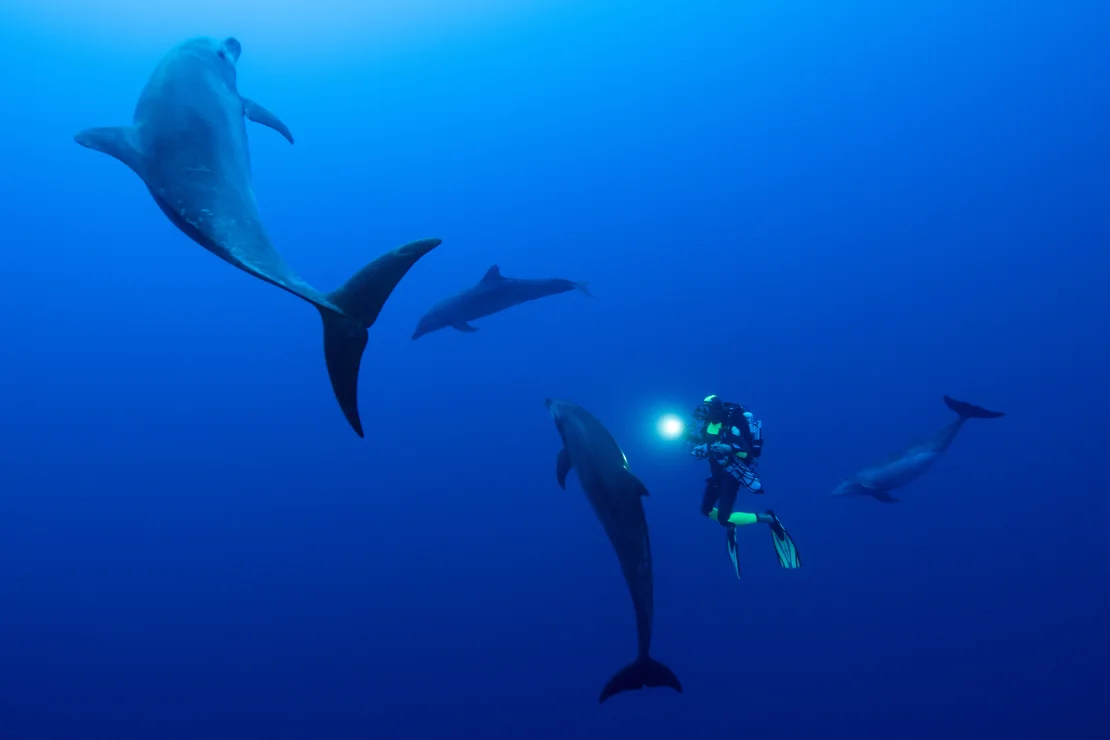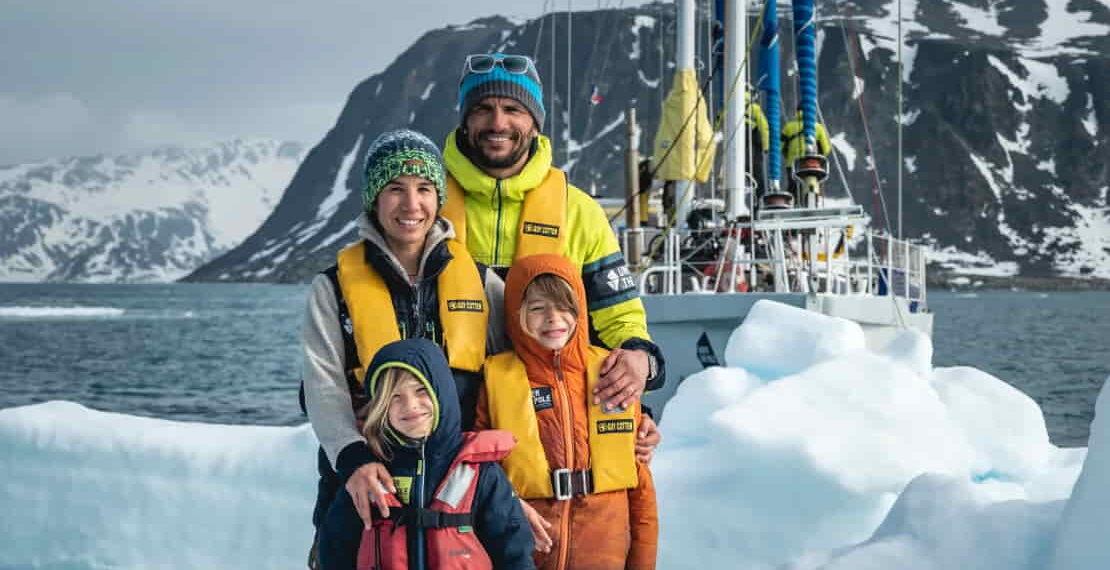A Family’s Life at Sea: Exploring the Deep Ocean and its Fragile Ecosystems
Not many children can say they took their first steps aboard a yacht in the Arctic’s northwest passage—but Tom can. For the first four years of his life, he and his family, Ghislain Bardout and Emmanuelle Périé-Bardout, spent much of their time at sea. The Bardouts are ocean explorers and founders of Under The Pole, an organization dedicated to documenting the mysteries of the deep ocean.
Tom and his older brother Robin, now 8 and 12, have spent roughly half their lives aboard the Bardouts’ expedition yacht, “The Why.” Their voyages have taken them from the icy polar regions to vibrant tropical reefs, all in pursuit of exploring the ocean’s “twilight” zone—an enigmatic area between 30 and 150 meters (100 to 490 feet) deep, often referred to as the mesophotic zone.
While their home base is in Concarneau, a coastal town in Brittany, France, the family’s true home is their 18-meter-long yacht, shared with scientists, doctors, a cook, and even a teacher. Despite their unusual lifestyle, Emmanuelle emphasizes that they maintain a regular routine, working and sending their children to school just like any other family.
However, the Bardouts’ work is anything but ordinary. Few people have witnessed the wonders they’ve explored beneath the surface, and that’s exactly the point.
Unveiling the Ocean’s Secrets
Although oceans cover 70% of the Earth, they remain some of the least understood ecosystems. Less than 30% of the seafloor has been mapped in detail, and it’s estimated that up to 91% of marine species are still unknown to science. The Bardouts believe that by documenting these underwater ecosystems, they can raise awareness of the environmental threats they face.
“The oceans are under immense stress,” says Emmanuelle. “From rising temperatures causing coral bleaching to pollution and overfishing, we must act now.”
Through their exploration, the Bardouts hope to shine a light on the fragility of these ecosystems and help protect them. In their latest mission, they focused on discovering and documenting “marine animal forests” in the Mediterranean Sea. These diverse underwater ecosystems, full of sponges, corals, and other marine life, act like terrestrial forests, offering shelter to countless species.
However, much like land forests, these underwater habitats are fragile. Disruptions, like bottom trawling—the fishing practice that drags nets along the ocean floor—can turn them into barren rocky deserts.

Protecting the Mediterranean’s Underwater Forests
The family recently spent several months investigating marine animal forests in the waters off Greece, Italy, and France. Their mission was part of Under The Pole’s DeepLife program, funded by the Rolex Perpetual Planet Initiative. These marine forests, rich in biodiversity, are crucial to the ocean’s health but are increasingly under threat. Over recent years, the Mediterranean has suffered from frequent marine heatwaves, killing off many surface ecosystems.
In Greece, the team ventured to Fourni, hoping to document a marine forest previously captured by an underwater drone. After facing setbacks due to signs of trawling damage, the team made a breakthrough when they discovered a thriving forest at a depth of 100 meters (328 feet).
“When you find a marine animal forest, it’s like finding an oasis—a rich, living ecosystem,” says Ghislain. “This is the kind of life we want to show the world.”
The team spent weeks collecting data on the ecosystem’s currents, acoustics, bacteria, and marine life. They plan to present their findings at the United Nations Ocean Conference in France in June 2025, hoping to influence global policy on protecting these vital ecosystems and curbing destructive fishing practices.
Pioneering Deep Sea Exploration
In recent years, technological advancements have allowed for deeper dives into the ocean’s twilight zone, but this remains a specialized and dangerous operation. Divers use “rebreathers”—military-grade equipment that recycles carbon dioxide into oxygen, allowing for longer, bubble-free dives.
During typical missions, lasting six to seven months, the team completes between 300 and 400 dives, each lasting three to six hours, with a substantial portion of that time spent ascending to allow the body to decompress. The process is physically demanding, with divers sometimes losing several kilograms during a single dive.
“The deeper you go, the faster time seems to fly,” Ghislain explains. “At 100 meters, you focus on the task—taking samples, deploying sensors, capturing images—and before you know it, it’s time to ascend.”
This intense physical toll can lead to serious health risks, including decompression sickness. Yet, despite the dangers, the Bardouts continue their exploration because they understand its importance in the fight against climate change.
A Legacy of Exploration and Hope
For Emmanuelle and Ghislain, the work they do is more than just a passion—it’s a responsibility. Since becoming parents, their approach to diving has become more cautious. The safety of their family is always a priority, but they remain dedicated to their mission.
Emmanuelle recalls being inspired as a child by French underwater explorer Jacques Cousteau. Now, she and her children live that same adventurous life, exploring uncharted waters and discovering hidden ecosystems.
“I don’t think our kids realize how lucky they are,” she says. “We can nurture their curiosity and show them a world few people will ever see.”
In many ways, Tom and Robin represent the future the Bardouts are working to protect. Over years of exploration, they have witnessed firsthand the devastating effects of climate change, and they believe it’s their generation’s duty to act.
“Humanity is destroying its environment,” says Ghislain. “This is the challenge of our century, and one we must address for the sake of the next generation.”
Through their ongoing explorations, the Bardouts hope to inspire a new wave of environmental stewardship and help preserve the ocean’s fragile ecosystems for years to come.
This article was rewritten by JournosNews.com based on verified reporting from trusted sources. The content has been independently reviewed, fact-checked, and edited for accuracy, neutrality, tone, and global readability in accordance with Google News and AdSense standards.
All opinions, quotes, or statements from contributors, experts, or sourced organizations do not necessarily reflect the views of JournosNews.com. JournosNews.com maintains full editorial independence from any external funders, sponsors, or organizations.
Stay informed with JournosNews.com — your trusted source for verified global reporting and in-depth analysis. Follow us on Google News, BlueSky, and X for real-time updates.














